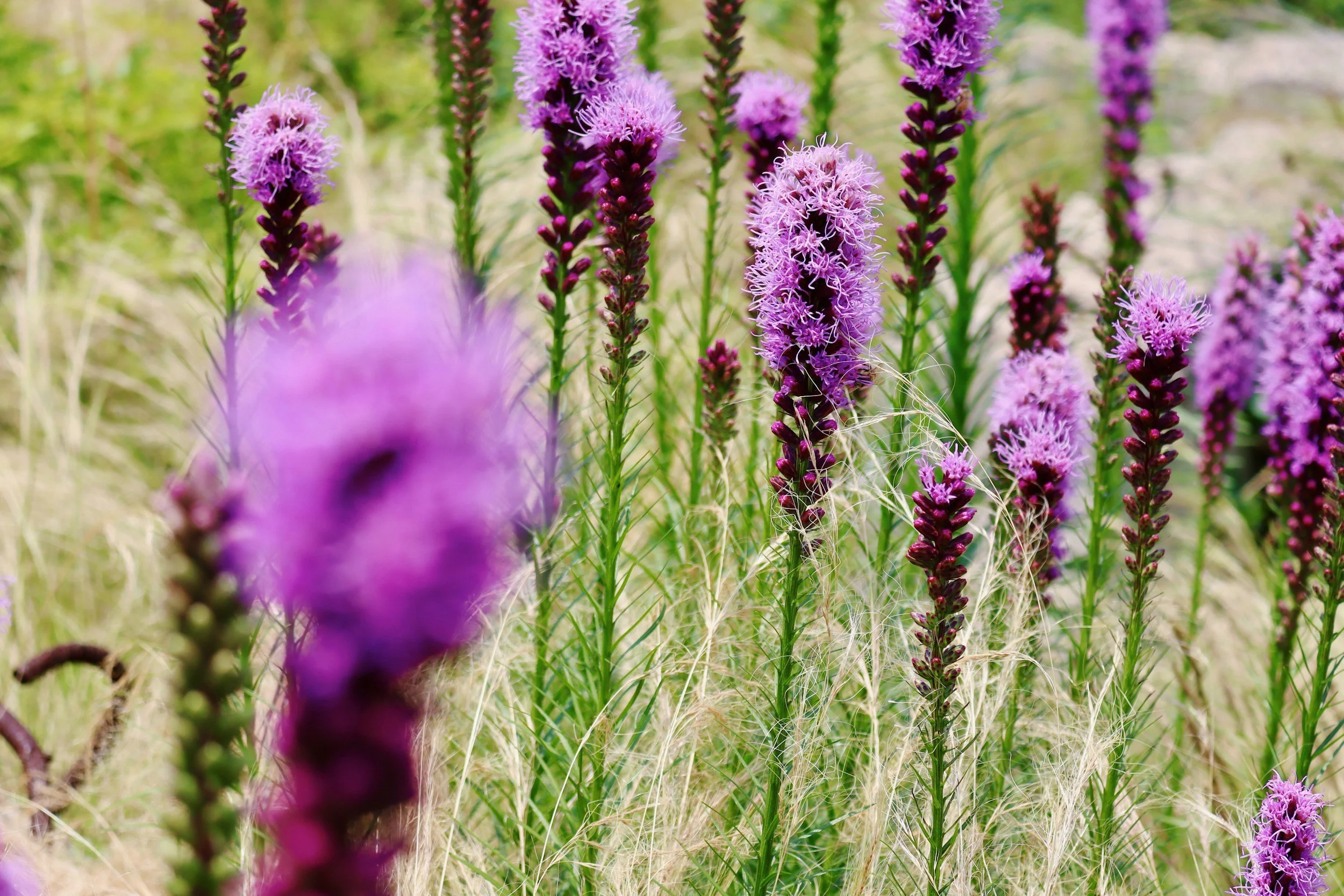
🌿 Overview: Liatris spicata (Dense Blazing Star)
Family: Asteraceae (Aster family)
Common Names: Dense blazing star, marsh blazing star, spike gayfeather
Plant Type: Herbaceous perennial
Native Range: Eastern and central North America
Height: Typically 2–4 ft
Bloom Time: Mid- to late summer (July to September)
Bloom Color: Purple to lavender (rarely white)
Sun Requirements: Full sun
Soil Preference: Medium to moist, well-drained soils; tolerates clay and seasonally wet soils
Ecoregions: Includes native range across tallgrass prairie, mesic savanna, moist meadow, and wetland edges
🌍 Native Range
Liatris spicata is native to the eastern half of the United States, from Wisconsin and Michigan south to Florida, and as far west as Missouri, Arkansas, and eastern Texas. It is native to Illinois, including the Chicago region, where it naturally occurs in moist prairies, sedge meadows, and fens.
🐝 Ecological Value
1. Nectar & Pollen Resource
Highly attractive to pollinators due to its upright, densely packed flower spikes that bloom from top to bottom, providing a long-lasting food source.
Provides abundant nectar for a wide range of long-tongued and short-tongued bees, butterflies, and specialist wasps.
Offers pollen for bees and shelter for smaller beneficial insects among its dense foliage.
2. Host Plant Role
Supports several species of moth caterpillars that feed on the foliage or flowers.
Valuable component of butterfly and pollinator gardens, especially in native plantings, prairie restorations, and wetland buffers.
🦋 Native Pollinators It Supports
Bees
Bumble bees (Bombus spp.) – primary nectar foragers
Sweat bees (Halictidae)
Leafcutter bees (Megachile spp.)
Long-horned bees (Melissodes spp.)
Carpenter bees (Xylocopa spp.)
Butterflies
Monarch (Danaus plexippus) – nectar source (not a host plant)
Eastern tiger swallowtail (Papilio glaucus)
Painted lady (Vanessa cardui)
Silver-spotted skipper (Epargyreus clarus)
Beneficial Wasps
Includes thread-waisted wasps, sand wasps, and ichneumonid wasps that hunt pest insects
Other Insect Visitors
Hoverflies (Syrphidae) – important native pollinators and aphid predators
Beetles, such as soldier beetles (Chauliognathus spp.), also feed on pollen and nectar
🐛 Insects That Use Liatris spicata as a Host Plant
While Liatris spicata is not as widely known as a larval host as milkweeds or oaks, it still supports some specialist moth species, including:
Glorious flower moth (Schinia gloriosa) – larvae feed on Liatris flowers and buds
Liatris flower moth (Schinia sanguinea) – a specialist dependent on Liatris species
Blazing star stem borer (Papaipema beeriana) – larvae tunnel into stems of Liatris
Cremastobombycia ignota (a leaf miner moth) – larvae mine leaves of Liatris and other Asteraceae
These insects often go unnoticed but play crucial roles in native food webs as prey for birds, parasitic wasps, and other insects.
🌱 How to Grow Liatris spicata from Seed to Flower
1. Seed Starting
Cold stratification required:
Refrigerate seeds for 30–60 days in moist sand or peat to break dormancy.
Sow in early spring or late fall (outdoors) or start indoors in late winter after stratification.
2. Germination
Germinates in 2–4 weeks at ~70°F
Sow thinly on surface or barely press into soil
Requires light to germinate, so don’t cover with soil
3. Transplanting
Transplant seedlings when they develop 2–3 true leaves
Space 12–18 inches apart in full sun
Avoid overly dry or compacted soils in early development
4. Site Requirements
Prefers full sun, at least 6 hours/day
Thrives in moist to mesic soil; tolerates occasional flooding and poor drainage
Does best in loamy or clay-loam soils but will tolerate sandy soils if not too dry
5. Care and Maintenance
Low maintenance once established
Deadheading extends bloom and reduces reseeding
Divide clumps every 3–4 years to maintain vigor
Tolerates drought once established, but appreciates occasional watering in dry spells
Resistant to deer and rabbit browsing
6. Blooming Timeline
Seed-grown plants typically bloom in 2nd or 3rd year
Flowering occurs July to September
Flowers bloom top to bottom on the spike, a unique trait
🌼 Companion Plants in a Native Garden
Pairs well with other moisture-tolerant or mesic native species such as:
Echinacea purpurea (Purple coneflower)
Rudbeckia fulgida (Orange coneflower)
Asclepias incarnata (Swamp milkweed)
Monarda fistulosa (Wild bergamot)
Pycnanthemum virginianum (Mountain mint)